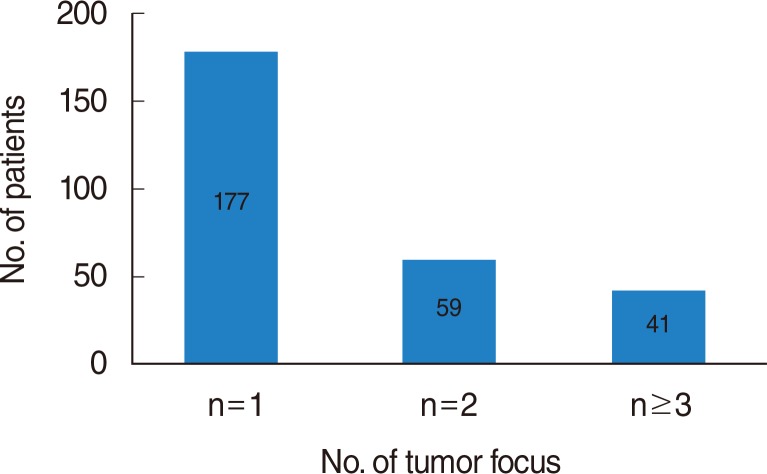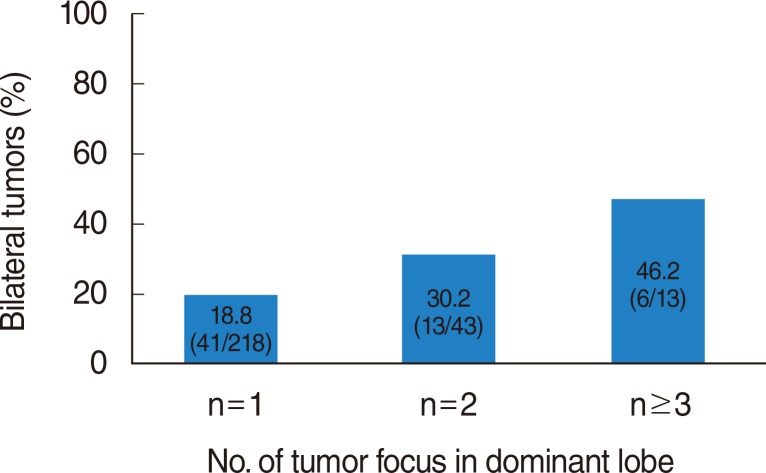1. Carcangiu ML, Zampi G, Rosai J. Papillary thyroid carcinoma: a study of its many morphologic expressions and clinical correlates. Pathol Annu. 1985; 20 Pt 1:1–44. PMID:
3887295.
2. Hawk WA, Hazard JB. The many appearances of papillary carcinoma of the thyroid. Cleve Clin Q. 1976; Winter. 43(4):207–215. PMID:
1000814.

3. Iida F, Yonekura M, Miyakawa M. Study of intraglandular dissemination of thyroid cancer. Cancer. 1969; 10. 24(4):764–771. PMID:
5821759.

4. Katoh R, Sasaki J, Kurihara H, Suzuki K, Iida Y, Kawaoi A. Multiple thyroid involvement (intraglandular metastasis) in papillary thyroid carcinoma: a clinicopathologic study of 105 consecutive patients. Cancer. 1992; 9. 70(6):1585–1590. PMID:
1516009.

5. Russell WO, Ibanez ML, Clark RL, White EC. Thyroid carcinoma: classification, intraglandular dissemination, and clinicopathological study based upon whole organ sections of 80 glands. Cancer. 1963; 11. 16:1425–1460. PMID:
14086580.
6. Tscholl-Ducommun J, Hedinger CE. Papillary thyroid carcinomas: morphology and prognosis. Virchows Arch A Pathol Anat Histol. 1982; 396(1):19–39. PMID:
7123844.
7. Mazzaferri EL, Jhiang SM. Long-term impact of initial surgical and medical therapy on papillary and follicular thyroid cancer. Am J Med. 1994; 11. 97(5):418–428. PMID:
7977430.

8. Iacobone M, Jansson S, Barczynski M, Goretzki P. Multifocal papillary thyroid carcinoma: A consensus report of the European Society of Endocrine Surgeons (ESES). Langenbecks Arch Surg. 2014; 2. 399(2):141–154. PMID:
24263684.
9. Li X, Zhao C, Hu D, Yu Y, Gao J, Zhao W, et al. Hemithyroidectomy increases the risk of disease recurrence in patients with ipsilateral multifocal papillary thyroid carcinoma. Oncol Lett. 2013; 4. 5(4):1412–1416. PMID:
23599804.

10. Lin JD, Chao TC, Hsueh C, Kuo SF. High recurrent rate of multicentric papillary thyroid carcinoma. Ann Surg Oncol. 2009; 9. 16(9):2609–2616. PMID:
19533244.

11. Basser AG, Rundle FF. Stump recurrence and total thyroidectomy in papillary thyroid cancer. Cancer. 1956; Jul-Aug. 9(4):692–697. PMID:
13356248.

12. Park SY, Park YJ, Lee YJ, Lee HS, Choi SH, Choe G, et al. Analysis of differential BRAF(V600E) mutational status in multifocal papillary thyroid carcinoma: evidence of independent clonal origin in distinct tumor foci. Cancer. 2006; 10. 107(8):1831–1838. PMID:
16983703.
13. Giannini R, Ugolini C, Lupi C, Proietti A, Elisei R, Salvatore G, et al. The heterogeneous distribution of BRAF mutation supports the independent clonal origin of distinct tumor foci in multifocal papillary thyroid carcinoma. J Clin Endocrinol Metab. 2007; 9. 92(9):3511–3516. PMID:
17535994.

14. Shattuck TM, Westra WH, Ladenson PW, Arnold A. Independent clonal origins of distinct tumor foci in multifocal papillary thyroid carcinoma. N Engl J Med. 2005; 6. 352(23):2406–2412. PMID:
15944425.

15. American Thyroid Association (ATA) Guidelines Taskforce on Thyroid Nodules and Differentiated Thyroid Cancer. Cooper DS, Doherty GM, Haugen BR, Kloos RT, Lee SL, et al. Revised American Thyroid Association management guidelines for patients with thyroid nodules and differentiated thyroid cancer. Thyroid. 2009; 11. 19(11):1167–1214. PMID:
19860577.

16. Connor MP, Wells D, Schmalbach CE. Variables predictive of bilateral occult papillary microcarcinoma following total thyroidectomy. Otolaryngol Head Neck Surg. 2011; 2. 144(2):210–215. PMID:
21493418.

17. Kim ES, Kim TY, Koh JM, Kim YI, Hong SJ, Kim WB, et al. Completion thyroidectomy in patients with thyroid cancer who initially underwent unilateral operation. Clin Endocrinol (Oxf). 2004; 7. 61(1):145–148. PMID:
15212657.

18. Pasieka JL, Thompson NW, McLeod MK, Burney RE, Macha M. The incidence of bilateral well-differentiated thyroid cancer found at completion thyroidectomy. World J Surg. 1992; Jul-Aug. 16(4):711–716. PMID:
1413840.

19. Perros P, Boelaert K, Colley S, Evans C, Evans RM, Gerrard Ba G, et al. Guidelines for the management of thyroid cancer. Clin Endocrinol (Oxf). 2014; 7. 81(Suppl 1):1–122. PMID:
24989897.

20. Hay ID, Hutchinson ME, Gonzalez-Losada T, McIver B, Reinalda ME, Grant CS, et al. Papillary thyroid microcarcinoma: a study of 900 cases observed in a 60-year period. Surgery. 2008; 12. 144(6):980–987. PMID:
19041007.

21. Roti E, degli Uberti EC, Bondanelli M, Braverman LE. Thyroid papillary microcarcinoma: a descriptive and meta-analysis study. Eur J Endocrinol. 2008; 12. 159(6):659–673. PMID:
18713843.







 PDF
PDF Citation
Citation Print
Print


 XML Download
XML Download